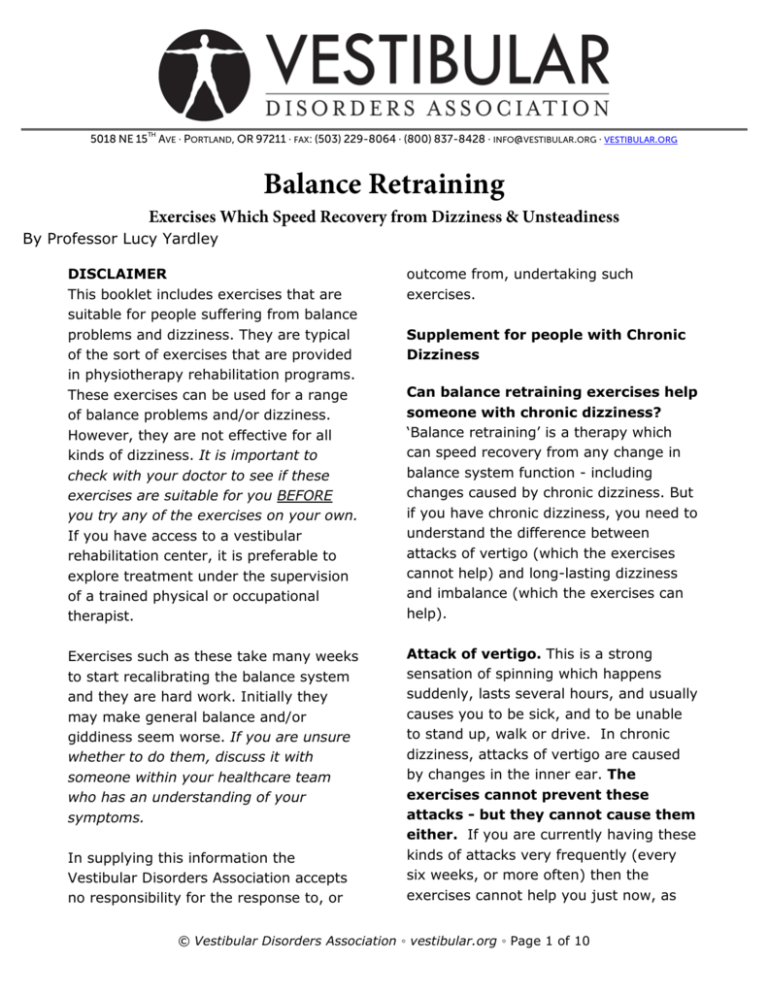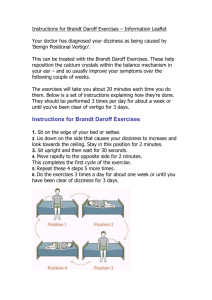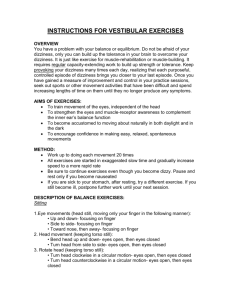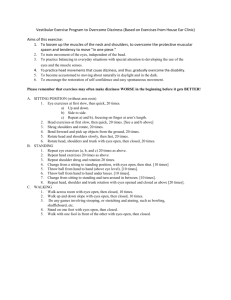Balance Retraining - Vestibular Disorders Association
advertisement

TH 5018 NE 15 AVE · PORTLAND, OR 97211 · FAX: (503) 229-8064 · (800) 837-8428 · INFO@VESTIBULAR.ORG · VESTIBULAR.ORG Balance Retraining Exercises Which Speed Recovery from Dizziness & Unsteadiness By Professor Lucy Yardley DISCLAIMER This booklet includes exercises that are suitable for people suffering from balance problems and dizziness. They are typical of the sort of exercises that are provided in physiotherapy rehabilitation programs. These exercises can be used for a range of balance problems and/or dizziness. However, they are not effective for all kinds of dizziness. It is important to check with your doctor to see if these exercises are suitable for you BEFORE you try any of the exercises on your own. If you have access to a vestibular rehabilitation center, it is preferable to explore treatment under the supervision of a trained physical or occupational therapist. Exercises such as these take many weeks to start recalibrating the balance system and they are hard work. Initially they may make general balance and/or giddiness seem worse. If you are unsure whether to do them, discuss it with someone within your healthcare team who has an understanding of your symptoms. In supplying this information the Vestibular Disorders Association accepts no responsibility for the response to, or outcome from, undertaking such exercises. Supplement for people with Chronic Dizziness Can balance retraining exercises help someone with chronic dizziness? ‘Balance retraining’ is a therapy which can speed recovery from any change in balance system function - including changes caused by chronic dizziness. But if you have chronic dizziness, you need to understand the difference between attacks of vertigo (which the exercises cannot help) and long-lasting dizziness and imbalance (which the exercises can help). Attack of vertigo. This is a strong sensation of spinning which happens suddenly, lasts several hours, and usually causes you to be sick, and to be unable to stand up, walk or drive. In chronic dizziness, attacks of vertigo are caused by changes in the inner ear. The exercises cannot prevent these attacks - but they cannot cause them either. If you are currently having these kinds of attacks very frequently (every six weeks, or more often) then the exercises cannot help you just now, as © Vestibular Disorders Association ◦ vestibular.org ◦ Page 1 of 10 recovery takes at least six weeks even with the exercises. quickly, using the exercises to help to clear up symptoms. Long-lasting dizziness and imbalance. The changes in the inner ear which cause an attack of vertigo result in a change in the signals given out by the faulty balance organ. Over time, your brain adjusts to these new signals (the booklet explains how this happens), and so you become less dizzy. Balance retraining exercises can speed this process of recovery. Common Questions About Dizziness Attacks of vertigo do not normally occur very often - usually there are many months or even years between attacks, although there are sometimes periods when the attacks occur frequently. But you may find that in between the attacks of vertigo you have long-lasting symptoms, such as dizziness, nausea, unsteadiness, tiredness, or a ‘hangover’ feeling. These symptoms often become worse when you are physically active, tired, stressed, or when you travel. The exercises can help you to clear up these symptoms during the period in between attacks of vertigo. Of course, after you have cleared up the long-lasting symptoms, you may have another attack of vertigo. In this case, you will have to start all over again, using the exercises to speed recovery. But people with Chronic dizziness who have tried these exercises say that they give them confidence that they will be able to get over their next attack of vertigo more Why do I feel dizzy, disoriented or unsteady? The balance system relies on three different senses. Using your eyes you can see where you are and where you are going. Using the sensors in your body you can feel where you are and how you are moving. And the balance organ in your inner ear (which doctors sometimes refer to as the vestibular organ or labyrinth) senses whenever your head moves. Your brain acts like a computer, combining signals from these three senses to give you a stable picture of the world and control your head, body and eye movements. If any part of this balance system is giving out unusual or faulty information then you may feel dizzy, disoriented or unsteady. What causes dizziness and imbalance? The balance system can be affected by many different medical problems, and so it is important to see your doctor and check which part of the balance system is not working normally. If your symptoms seem to be caused by your balance organ your doctor may tell you that you have vertigo, or vestibular imbalance. This can result from a mild virus or ear infection, or sometimes just wear and tear on the balance organ. Sometimes your doctor © Vestibular Disorders Association ◦ vestibular.org ◦ Page 2 of 10 will not be able to discover why the dizziness started, but balance retraining can still help to speed recovery even when the cause for the dizziness is not known. If your balance system is not working normally, then you may find that you become dizzy whenever you make quick or unusual movements, such as reaching up or looking behind you. You may also become dizzy when you are moved (e.g. in cars or lifts), or when you are in a situation with a lot of moving lights, objects or people (e.g. in busy traffic). Is dizziness abnormal or harmful? If your balance system is not working normally, it is very rare for this to be because of a dangerous medical condition. But although dizziness is not usually a sign of a dangerous illness, it is very unpleasant and frightening and can cause other symptoms and nausea, tiredness and difficulty concentrating. Often people who are dizzy avoid physical activity and quick movements, and this can lead to other health problems such as a stiff neck and headaches, and becoming unfit. Because of dizziness people sometimes end up avoiding even vital activities, such as working, travelling or going out alone. You need to have good balance as you get older, to reduce the risk of falling and hurting yourself. So even though dizziness is not usually due to serious illness, it is still important to speed recovery from it. What can I do to speed recovery? The bad news is that there is no medicine which can make the balance system work normally. Your doctor may be able to give you tablets to ease the dizziness and nausea, but these will not cure the problem. Sometimes the dizziness will clear up over a month or two, if you keep up your normal activities (see next section). If this has not happened, then the good news is that you can speed this natural recovery process using the exercises in this booklet. How do balance retraining exercises speed recovery? Recovering from dizziness is exactly the same as getting your sea legs. At first being at sea makes people unsteady and sick, but if you stay at sea then gradually the brain learns to cope with the new balance signals from the eyes, body and balance organs, and the sickness disappears. In the same way, the brain can gradually overcome dizziness and imbalance due to a change in the way the balance system is working, following injury or illness. But your system can only learn to cope with the new balance signals if you practice the activities which cause dizziness. Balance retraining exercises give your balance system all the practice it needs, at a time and place where you will not be distracted or put at risk. How can I tell if these exercises will help me? In scientific studies, 75%-80% (four out of five people) who were taught these © Vestibular Disorders Association ◦ vestibular.org ◦ Page 3 of 10 exercises reported feeling better within a few months. A comparison group of people who were not taught the exercises did not get any improvement in their dizziness. To find out whether these exercises are right for you, simply try out the exercises on the next pages. If they do not make you dizzy, even when you carry them out at top speed, then they will not help you. If they make you dizzy then this is a sign that your system needs practice with these activities. Until your system has learned to cope with these movements, you will become dizzy whenever you have to carry out these movements as part of your normal daily activities. Can these exercises do me any harm? The exercises are based on normal head movements that you should be able to make during your daily life, and so they will be totally safe unless you have been told you should avoid these head movements. If you feel a bit more dizzy when you start the exercises this just means that they are working – they cannot cause any damage to the balance system – but you may want to practice them more slowly at first. If you have a stiff neck, you will also need to make the movements gently to start with, but the exercises should gradually help to ease the stiffness. If the exercises seem to bring on any of the symptoms listed below (which is very unlikely), or if you have these symptoms already, you should not carry on with the exercises until your doctor has said it is safe for you to do them. Avoid doing the exercises if doing them seems to cause any of these symptoms: sharp, severe or prolonged pain in your neck, head or ear; a feeling of fullness in the ear; deafness or noises in the ear; fainting with loss of consciousness or blacking out; double vision; numbness, weakness or tingling in your arms and legs. If doing this makes you begin to black out, visit your doctor. Carrying out the exercises How to design the right exercise program for you Everyone’s lifestyle is different, and different movements make different people dizzy. This page shows you how to design an exercise programme which will suit you. © Vestibular Disorders Association ◦ vestibular.org ◦ Page 4 of 10 1. The first vital step is to find a good time to carry out the exercises. They take less than 10 minutes, and it is very important that you practice them every day – even better, twice a day. Decide now on two times when you will try to do them, and write them times down on the exercise sheet at the back of this book. 2. Next choose a place to do them – somewhere that you can sit down and walk about safely without tripping over things or knocking on hard objects (e.g. beside your bed or the sofa). 3. Now you need to choose which exercises to do this week, using the timed exercise scoring test. For this, you may find it helpful to ask a relative or friend to help you time how fast you do the exercises – and to encourage you! Timed exercise scoring test • First carry out the shaking exercise on the next page sitting down • After you have finished, wait 10 seconds, and then write down how dizzy you feel on the exercise sheet, on the line labeled shaking, under Week1, using the scores shown at the top of the page • Put an S by each score to show you did the exercise sitting down • Do the same for each of the 6 basic exercises on the next page Use the scores on your exercises sheet to decide which exercises to do for the next week: If you have written 0 by an exercise, you do not need to do it (as it causes no symptoms) If you have written 1 or 2 by an exercise, you need to practice it daily. If you have written 3 by an exercise, you need to practice it more slowly at first, every day. Week 1 2 Shake 1S 1S Nod 0S 1ST Shake EC 2S 1S Nod EC 0S 2ST Shake/stare 2S 2S Nod/stare 1S 0S In week 3, this person will need to practice the nod exercises standing up and the shake exercises sitting down. The basic exercises It helps to breathe slowly if you feel dizzy – no more than one breath every four to six seconds. To loosen up before starting, gently shrug your shoulders and circle them around a few times. 1. Shake: Turn your head from right to left and back again 10 times in 10 seconds. Twist your head round as far as it will go comfortably when you do this, and look in the direction your head is pointing. Wait 10 seconds © Vestibular Disorders Association ◦ vestibular.org ◦ Page 5 of 10 2. 3. 4. 5. 6. after you have done 10 complete turns, then do 10 more. Nod: Nod your head up and down and back again 10 times in 10 seconds. Tip your head as far as it will go comfortably when you do this, and look in the direction your head is pointing. Wait 10 seconds after you have done 10 complete turns, then do 10 more. Shake, eyes closed (EC): Carry out the shake exercise with your eyes closed. Wait 10 seconds after you have done 10 complete turns, then do 10 more. Nod, eyes closed (EC): Carry out the nod exercise with your eyes closed. Wait 10 seconds after you have done 10 complete turns, then do 10 more. Shake/stare: Hold your finger pointing upwards in front of you and carry out the shake exercise while staring at your finger. Do not let your eyes move from your finger. Wait 10 seconds after you have done 10 complete turns, then do 10 more. Nod/stare: Hold your finger pointing sideways in front of you and carry out the nod exercise while staring at your finger. Do not let your eyes move from your finger. Wait 10 seconds after you have done 10 complete turns, then do 10 more. As well as these basic exercises, you should choose some special exercises and general activities. Changing the exercise program to suit your stage of recovery When you first start carrying out the exercises they will make you a little dizzy. If the dizziness starts to interfere with your daily activities, then do the exercises a little more slowly at first, but do not skip them – it is only with regular practice that your balance system can recover. Most people have good days and bad days at first. It is quite normal to find that the dizziness gets worse for a time when you are tired or stressed, or if you get a cold or flu. But after a few weeks of regular daily practice you will notice that the exercises are starting to make you less dizzy. Then you should gradually do the exercises more quickly, until you can do them at full speed. After a while some exercises will no longer make you dizzy, and you will not need to practice them anymore. You need to check which exercises you need to do that the start of each week, by repeating the timed exercise scoring test. If you score 0 for any of the exercises (or if you score only 1 for several weeks), then you should make that exercise more difficult as follows. Making the exercises more difficult (as you recover) 1. If you can do an exercise at full speed with almost no dizziness while sitting down, then try doing it standing up. © Vestibular Disorders Association ◦ vestibular.org ◦ Page 6 of 10 2. If you can do an exercise at full speed with almost no dizziness while standing up, then try doing it while walking a few paces backwards and forwards (you will probably find turning most tricky!). 3. Once you can do the exercises at full speed while walking backwards and forwards your balance system has had all the practice it needs – you can tick this exercise off and do not need to do it anymore. Adding general activities to your exercise program Physical activity as part of your daily life also helps your balance system to recover. It is especially important to practice any activities you may have given up because of dizziness. Read through the tips for choosing physical activity below, and then write down an activity you will practice each week on the exercise sheet. Ball games Catching a ball gives your balance system very good practice with quick eye, head and body movements. Get a soft ball, and practice throwing it above your head and then catching it. Like the basic exercises, you can start by doing this while sitting down, then standing up, and finally while walking. Walking If you have poor balance then simply walking for five to ten minutes a day will help it to improve. If you have no problems walking on a flat surface, you may still need to practice walking over rough ground, or up and down slopes or stairs. If walking around a busy town centre makes you dizzy, then practice in gradual stages. You could start by walking down to the end of your street and back for the first week. The following week, walk to the nearest busy road and watch the moving traffic until it does not make you dizzy. The next week walk along the busy road to the nearest shop and back – until eventually you are ready to practice walking in a place with lots of moving crowds and traffic. Sport, dance and exercise Once your dizziness in nearly better, then sport, dance or exercise (e.g. yoga or keep fit) can help you balance system return to normal. Travel You may have found that you become dizzy when travelling by car, bus, train or boat, or in a lift or an escalator. The only way to get over this dizziness is with practice! Start by practising short trips as often as possible, e.g. travelling one or two stops on the bus, or a short car trip. Gradually practice longer trips as your dizziness gets less bad. © Vestibular Disorders Association ◦ vestibular.org ◦ Page 7 of 10 Adding special exercises to your exercise programme Since different movements make different people dizzy, there may be some activities which you already know make you dizzy. If so, write them down as special exercises on the exercise sheet, and practice them daily. The special exercises listed below can help with the particular problem listed. Unsteadiness, poor balance If you have problems walking in a straight line, or tend to lose balance and fall over, then you need extra practice with balancing. Once you can do the basic exercises while walking, you may find it helpful to carry them out while standing on one leg (stand by a sofa or bed, so you have something soft to lean on if you start to fall!). You could also practice them standing with your feet heel to toe – this is very difficult. If turning over in bed makes you dizzy This is a very common problem which results from little particles floating into the wrong part of the balance organ. To help float the particles back out again, sit on the edge of the bed with your feet hanging down. Lie down as fast as you can on the side which makes you dizzy. Wait for 30 seconds, then sit up quickly and stay upright for 30 seconds. Now repeat this on the other side. If you do this exercise 10 times every day you will be very dizzy at first, but the dizziness should clear up in a few weeks. Reaching If you find that reaching up or down or behind you makes you dizzy, sit in a chair and practice looking at and touching places on the floor, above you, and behind you. (Do not practice this exercise if it makes you feel faint or as if you will lose consciousness). Dizziness caused by striped surfaces or moving objects, lights etc You may find you are made dizzy by vision – for example, when looking at stripes or scrolling computer screens, watching films, or looking at moving traffic or lights. If so, then stick a sheet of bright striped paper on the wall close to you, and practice carrying out the shake, nod, shake/stare and nod/stare exercises while facing this sheet of paper (sitting and then standing). Whenever possible, you should also practice the real-life situation which make you dizzy – for example, deliberately stare at moving traffic, or the scrolling computer screen. Timed Weekly Exercise Scoring Test Times for daily practice 1._________________ 2. _________________ © Vestibular Disorders Association ◦ vestibular.org ◦ Page 8 of 10 Week 1 2 3 4 5 6 7 8 9 1 0 1 1 Shake Nod Shake EC Nod EC 1 2 This booklet was written by Professor Lucy Yardley and produced by the University of Southampton with funding provided by the Ménière’s Society. It is recommended for use only after a qualified medical doctor has confirmed that the exercises are safe and appropriate for the individual who will carry them out. © Professor Lucy Yardley Shake /Stare Published with the support of The Meniere’s Society, a UK registered charity providing support and information to those with dizziness and balance disorders (www.menieres.org.uk) Nod/ Stare © Vestibular Disorders Association General comments: (note anything which seems to help, or any setbacks) VEDA’s publications are protected under copyright. For more information, see our permissions guide at www.vestibular.org. This document is not intended as a substitute for professional health care. © Vestibular Disorders Association ◦ vestibular.org ◦ Page 9 of 10 TH 5018 NE 15 AVE · PORTLAND, OR 97211 · FAX: (503) 229-8064 · (800) 837-8428 · INFO@VESTIBULAR.ORG · VESTIBULAR.ORG Did this free publication from VEDA help you? Thanks to VEDA, vestibular disorders are becoming widely recognized, rapidly diagnosed, and effectively treated. VEDA’s mission is to inform, support, and advocate for the vestibular community. You can help! Your tax-deductible gift makes sure that VEDA’s valuable resources reach the people who can benefit from them most – vestibular patients like you! JOIN VEDA TO DEFEAT DIZZINESS™ By making a donation of: $40 $75 Senior discounts are available; contact us for details. $100 $250 $1,000 $2,500 Members receive a Patient Toolkit, a subscription to VEDA’s newsletter, On the Level containing information on diagnosis, treatment, research, and coping strategies - access to VEDA’s online member forum, the opportunity to join V-PALS, a pen-pals network for vestibular patients, and more! For healthcare professionals: Individual and clinic/hospital memberships are available. Professional members receive a subscription to VEDA’s newsletter, a listing in VEDA’s provider directory, co-branded educational publications for their patients, access to a multi-specialty online forum, and the opportunity to publish articles on VEDA’s website. For details, call (800) 837-8428, email info@vestibular.org or visit https://vestibular.org/membership. MAILING INFORMATION Name ____________________________________________________________________________ Address __________________________________________City _____________________________ State/Province ________________ Zip/Postal code _____________Country ____________________ Telephone __________________________E-mail _________________________________________ Send my newsletter by email (Free) Send my newsletter by mail (U.S. – Free; $25 outside the U.S.) PAYMENT INFORMATION Check or money order in U.S. funds, payable to VEDA (enclosed) Visa MC Amex _____________________________________ ___________________ _____________ Card number Exp. date (mo./yr.) CSV Code ______________________________________________________________________ Billing address of card (if different from mailing information) Or visit us on our website at https://vestibular.org to make a secure online contribution.









